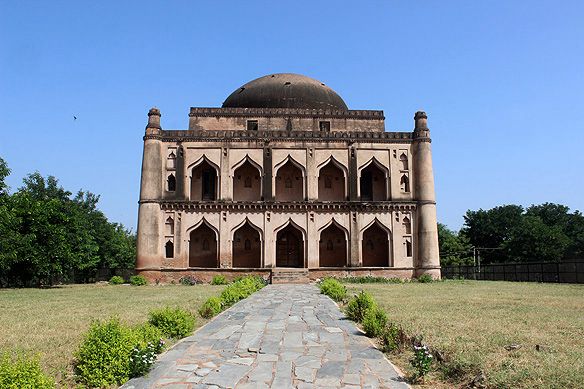
Narnaul, the city headquarters of Mahendargarh district, located in south Haryana is one of the very few places in India with the name of the district different from the name of the main city in the district. Located just 120 Km away from the shining skyscrapers of Gurugram, (better known as Haryana’s financial capital), the city has a rich historical past which dates back to ancient and medieval times. Once the abode of Mughal glory, Narnaul in contemporary times, at its best is known for its large bus depot, single-screen movie theatre, and few tombs. The city mainly comprises Yadavs along with a small chunk of Punjabis and Baniyas residing near the main cloth market of the city, in the present times. The politics in the region is mainly dominated by the Yadavs, with Rao Inderjit Singh being the major political force of the region. Along with him, ex-bureaucrat turned politician Rao Abhay Singh also emerged as the new popular political figure in recent times.
Moving back to the past, there are several legends regarding the origin of the city. One Legend has it that Narnaul was once Nar Rashtra, living during the Mahabharata period. Lions were said to have wandered freely in the neighboring jungles for approximately 900 years, according to another tradition. The settlement was named Naharnaul (Fear of Lions) after these lions. Another legend has it that Raja Launkaran (third Rao of Bikaner) called it Narlaun after his wife. As per the documented history, the town was initially ruled by the Jogis. Before the Mohammedans arrived, the town and its surrounding areas were also dominated by the Rathor Rajputs. With the Muslim rule asserting control over India, Sher Shah Suri’s grandfather Ibrahim Khan arrived in Narnaul first, and the place was strongly linked to the Sur-Afghans. In exchange for covering the costs of the forty-horseman militia, he obtained the town of Narnaul and the nearby villages from the then-administrator of Firoz-i-Hisar. After the death of Ibrahim Khan, Hasan Khan, father of Sher Shah Suri became the Jaghirdar of Narnaul.
The town reached its zenith under the rule of Shah Quli Khan, also known as the reason behind the survival of the Mughal Empire. The story goes back to the second battle of Panipat, where Shah Quli Khan’s destiny took a sharp turn. On November 5, 1556, to be precise, a fragmented and feeble kingdom was left to his 13-year-old son Akbar after Humayun passed away in a strange accident in Delhi earlier in the same year. There were very few if any, chances that the Mughal Empire would survive this tragedy. And to cap it all, a few weeks ago, Delhi was seized by the Hindu King Hemchandra Vikramaditya, also called Hemu, who was a skilled administrator and a superb military tactician. The fate of North India was to be decided that day between the two factions in a pivotal fight at Panipat. It was Hemu's advantage by all measures. Yet an arrow injured Hemu's eye just when it appeared that the Mughals would soon be defeated.
Hemu was executed after falling from the horse while blinded, being apprehended right away. The rest is history, as they say. Now that the main rival had been eliminated, Mughal power flourished and persisted for the following 300 years. The soldier who fired that pivotal, although accidental, arrow has been neatly forgotten by history. But Akbar, however, did not. The ordinary soldier became the most senior noble in his court when he was elevated to the position of Governor of Narnaul and bestowed with titles and benefits for the ensuing forty-two years. In addition to building tombs for himself and his family, Shah Quli Khan embellished Narnaul with Aram-E-Kauser, a private garden complex that housed Jal Mahal, a palace floating amidst a lake.
Another famous attraction of the city is ‘Birbal Ka Chattha’, which stands in the middle of the city reminding the visits of Birbal to the city. After Akbar’s rule, came the cruel tyrant Aurangzeb’s reign, and guess what! Satnamis, a sect of sadhus rose to revolt against Aurangzeb’s rule and the tyrant himself came to crush the rebellion. The Satnami Sadhus rose in rebellion against the Muslim Jaghirdar’s repression during the reign of tyrant Aurangzeb. A significant communal riot was the outward manifestation of the uprising. Satnamis took control of the town after executing the Muslim Faujdar. The imperial armies were positioned in the area quickly. Consequently, Aurangzeb himself had to arrive with a sizable contingent to put an end to this violence.
After a while, a Hindu Satnami girl was abducted by Taherbeg, the Nawab of Narnaul. Nawab Taherbeg was then engaged in combat with the Satnamis, “Satnamis Sat se lare, Lekar hath me Teg, Narnaul ka gorve, mara diya Taherbeg”, was the famous war cry of Satnamis who vehemently fought Taherbeg and ultimately killed him. Following the fall of the tyrant Aurangzeb, 4 Thakurs of Jaipur conquered Narnaul, only to lose it to the French General Do-Boigne shortly after. Later, Murtza Khan Bharaich acquired the Jagirdari of Narnaul. In 1857, Nawab of Jhajjar, descended from Abdur Rahman, raised a banner of rebellion against the British. After the Battle of Narnaul during the First War of Indian Independence in 1857, he along with some co-patriots was hanged. After independence Narnaul city came under the rule of east Punjab which eventually took shape as state of Haryana on 1st November 1966. Thus, this was the story of Narnaul city which once was the epicenter of nobles and royalty in medieval times, which is currently looking for a beam of hope for its revival.















